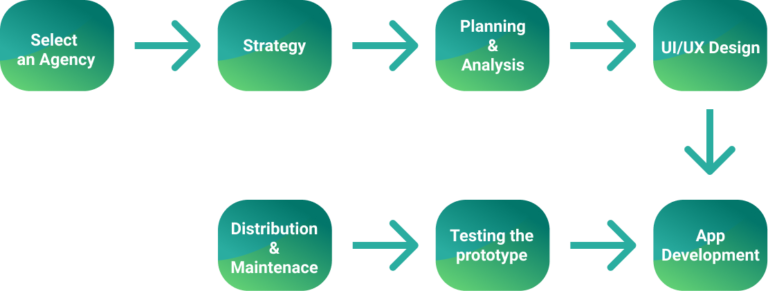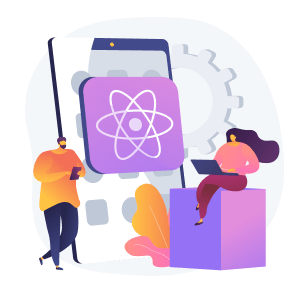
7 Stages of Mobile App Development Process 2021 Explained
Do you want to jump on the bandwagon of the mobile app world? Mobile apps are here to stay! You can get to know about the importance of mobile apps through the fact that in 2021 alone, mobile apps are estimated to generate revenues of $690 billion. [1]
This shows that companies and businesses that do not have a mobile app are not getting the customer engagement others are. In-house app development is not popular because of the complexity of the process. Mostly, companies and businesses outsource the process to development agencies.
Even if you plan to outsource the app development process, you should be aware of what goes on. 7 major stages make up the development process.
7 Stages of Mobile App Development 2021
Even though the development phase spans over several steps, we have condensed them into 7 key ones without which the process will not complete. You can call them the stepping stones of app development. One step leads to the second one and is crucial for app development. Whatever type of project you have; small or big, these are the main steps in every type of app development.

PHASE 1: Choose an Agency/Freelancer
The first step is to decide whether you want to go for in-house development or outsource. Most businesses opt for outsourcing as app development is a proper field that requires professional knowledge and expertise. Moreover, outsourcing also lets the business devote all the time to doing what they do best – business.
Shortlisting a company for outsourcing your app development project may be the most critical decision to make. It can make or break your entire project. So, we recommend spending maximum time researching about the company and try to shortlist the best one. The best thing is to go on different platforms, ask people who have got their apps developed by others and look for referrals. Keep the following points in mind when making the selection:
- Always shortlist 2-3 companies and take estimation from them.
- Do proper research, check the license of the companies and talk to old clients.
- Check what each company has quoted and see how the forecasts are similar and on what points are they different.
- Check and talk about intellectual rights. Your app should not be distributed to others and you should have all rights to it.
If you are developing an app in-house, you will start from PHASE 2 and skip PHASE
PHASE 2: Develop a Strategy
In this phase, you need to come up with a strategy. After all, you need to put your idea on paper and that can be done through proper strategizing. Each app is different from the rest, so there should be a proper way to approach things. This phase involves the following steps:
At the end of phase 2, you will get a clear idea of how your app will look like and what are the objectives and goals you want to achieve. Moreover, you can shortlist what your target audience is and which platform you want to publish your app on. Will it be a native app or a hybrid one?
PHASE 3: Planning and Analysis

If you see, you already have a rough sketch of how the mobile app will look in your mind. Can you envision it? You are already clear about what you want and only need to translate it into reality. In this step, you need to keep budget and time constraints in mind.
TIP: We always recommend going for an MVP (minimum viable product) for the first launch. This is economical and gives you an idea of how the app is going to perform. Moreover, for businesses short of time, this should be the priority. This phase includes two major outcomes as follows

The first part is to identify what skills you need to develop the app. This depends solely on the type of platform you are going to use. If you want to develop an app for iOS, you will require a different skill set when compared to developing apps for Android. Both the software have different technology stacks used for development.
So, your team selection will depend on which platform you are going for. If you want to go for a hybrid app, the best thing is to include developers for both platforms in your team.
Secondly, this is the phase where you are going to decide your app name. it is critical to search and see if the app name is available or not, so that you don’t get stuck in legal issues.
PHASE 4: UX/UI Design
Why do you want to develop a mobile app? Yes, it for connecting with the customers and increase customer engagement. The whole idea behind it is to give the users a seamless and excellent experience.
Have you ever thought about how an app becomes successful? A successful app is beneficial to the users because of its features and the advantages it has to offer. The goal of the UX/UI design is to give the users an intuitive, interactive and excellent experience. The polished UI design helps people adopt the app early. But, this is not all. You need to give the users something more to keep them engaged.
- Workflows: In this step, you need to determine what sort of data the app will be displaying. This is the data collection step. How will the data be displayed?
- Wireframes: Wireframes are the digital sketches of the mobile app. These are mockups that are low-fidelity and are conceptual. They provide a visual structure for the app’s requirements. In this phase, all the focus is on the aesthetic outlook of the app. Color scheme, app layout; graphics, etc are the main considerations.
- Style Guide: These are “living documents” where everything from the company’s brand on the app to the shape and color of the navigation buttons are documented and saved after being finalized. The following questions are answered:
- What font is going to be used?
- What is the color scheme?
- How will our company brand be represented and reflected in the app design?
Here, you need to be following either the app design guidelines from Apple or Google, depending on which platform you decide to put your app on.
- Mockups: Now that you have your app’s style guidelines and wireframes, you bring the two together and make a mockup. Adobe Photoshop is the best tool for making high-fidelity mockups. This is not the final phase. It requires a lot of modifications.
- Prototype: Mockups are used to display the functionality of your static designs. You can transform them into clickable prototypes with Figma and Invision. Even though it can be time-consuming and tedious. This is excellent for checking the app before it goes out to the public. This can save you from the hassle of high-end modification.
PHASE 5: App Development
To put the prototype in the transition phase to make it an actual, usable mobile app, the app development phase kicks in. You will be able to:
- Define and finalize the technical architecture.
- Finalize the technology stack.
- Establishing the development milestones.
- Backend Technology: Mostly, you will already have a back-end platform. For a specific end, you will have to modify it.
- API: Next, you have to establish the Application Programming Interface (API) for your app.
Front End of the Mobile App: This is the end where the user will be using the app. The back end and the API are for managing the data so that the front end of the app gives the best user experience possible.
PHASE 6: Testing the Prototype
Once you are done with the actual app development process, it is time to test your entire prototype. Quality Assurance (QA) testing will make sure that your app remains secure, stable and usable throughout. To ensure you have made a user-friendly app, there are certain tests to be performed.

PHASE 7: Distribution and Maintenance
Well done! Now that the app is made and has passed all tests, you can publish your app on the platform of your choice, whether it is iOS or Android or both. For that, you will need to have a developers account on Apple or Android.
For getting your app published, you need to have metadata including the following information:
- Name of the app
- Category
- Keyword
- Description
- Screenshot of the app
- Launch icons
Once you have submitted it, it will be reviewed by the store and then will be published once approved. There are many Key Performance Indicators (KPI) that need to be met before the app is published. Once everything is set, you are good to go.
The fun does not stop here. Frequent updates and maintenance are necessary to ensure that the users get the best experience throughout.
Conclusion
Mobile app development is surely an ongoing process that keeps on going till the life of the app. You need to be updated to meet the competitors in the market who come up with new features. Our 7 step strategy will help you develop better apps.
Share this post:

Web Development Agency
In the times of today, it is nearly impossible to even imagine that a company or business can survive and compete without an online presence in the market.

How to Become a Successful Full Stack Developer
The development of a software application can be broken down into 2 parts. The two areas of expertise are known as front-end and back-end development.

How To Setup A WordPress Development Environment?
Are you working on WordPress development frequently? 5 Steps to Setup a WordPress Development Environment
Connect with us to find out what true value added services are.
contact@sourceone.io
Headquarters – Ho Chi Minh city, Vietnam
(+84) 353 197 427
Brand – Sydney, Australia
(+61) 401 713 724
About SourceOne
Privacy
Terms of Use
Mobile application
Website and API Services
UI/UX Design
Next – Gen Technology
NEWSLETTER
Join us for get latest updates




